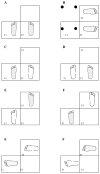Reliability and comparison of weight-bearing ability during standing tasks for individuals with chronic stroke
- PMID: 12161837
- PMCID: PMC3501528
- DOI: 10.1053/apmr.2002.33644
Reliability and comparison of weight-bearing ability during standing tasks for individuals with chronic stroke
Abstract
Objectives: To determine the test-retest reliability over 2 separate days for weight-bearing ability during standing tasks in individuals with chronic stroke and to compare the weight-bearing ability among 5 standing tasks for the paretic and nonparetic limbs.
Design: Prospective study using a convenient sample.
Setting: Free-standing tertiary rehabilitation center.
Participants: Fifteen community-dwelling stroke individuals with moderate motor deficits; volunteer sample.
Interventions: Not applicable.
Main outcome measures: Weight-bearing ability as measured by the vertical ground reaction force during 5 standing tasks (rising from a chair, quiet standing, weight-shifting forward, backward, laterally).
Results: The weight-bearing ability was less for the paretic limb compared with the nonparetic limb, but the intraclass correlation coefficients were high (.95-.99) for both limbs between the 2 sessions for all 5 tasks. The forward weight-shifting ability was particularly low in magnitude on the paretic side compared with the other weight-shifting tasks. In addition, the forward weight-shift ability of the nonparetic limb was also impaired but to a lesser extent. Large asymmetry was evident when rising from a chair, with the paretic limb bearing a mean 296N and the nonparetic side bearing a mean 458N. The weight-bearing ability during all 5 tasks correlated with one another (r range,.56-.94).
Conclusions: Weight-bearing ability can be reliably measured and may serve as a useful outcome measure in individuals with stroke. We suggest that impairments of the hemiparetic side during forward weight shifting and sit-to-stand tasks presents a challenge to the motor systems of individuals with stroke, which may account for the poor balance that is often observed in these individuals.
Copyright 2002 by the American Congress of Rehabilitation Medicine and the American Academy of Physical Medicine and Rehabilitation
Figures

References
-
- Dickstein R, Nissan M, Pillar T, Scheer D. Foot-ground pressure pattern of standing hemiplegic patients: Major characteristics and patterns of improvement. Phys Ther. 1984;64:19–23. - PubMed
-
- Laufer Y, Dickstein R, Resnik S, Marcovitz E. Weight-bearing shifts of hemiparetic and healthy adults upon stepping on stairs of various heights. Clin Rehabil. 2000;14:125–129. - PubMed
-
- Mizrahi J, Solzi P, Ring H, Nisell R. Postural stability in stroke patients: Vectorial expression of asymmetry, sway activity and relative sequence of reactive forces. Med & Biol Eng & Comput. 1989;27:181–190. - PubMed
-
- Sackley CM. The relationships between weight-bearing asymmetry after stroke, motor function and activities of daily living. Physiother Theory Prac. 1990;6:179–185.
-
- Shumway-Cook A, Anson D, Haller S. Postural sway biofeedback: Its effect on reestablishing stance stability in hemiplegic patients. Arch Phys Med Rehabil. 1988;69:395–400. - PubMed
Publication types
MeSH terms
Grants and funding
LinkOut - more resources
Full Text Sources
Medical

